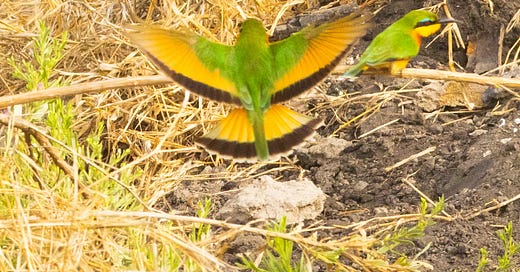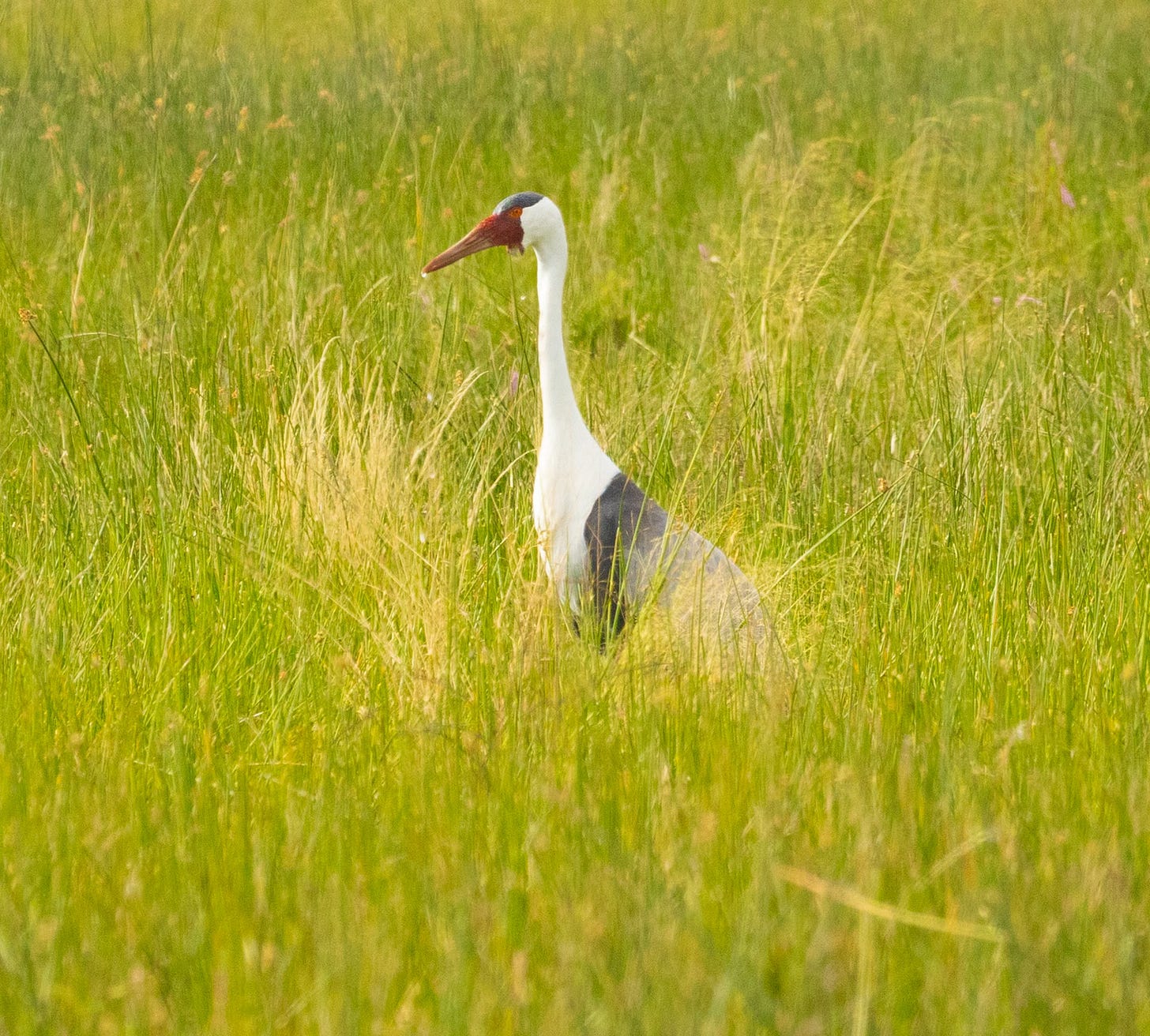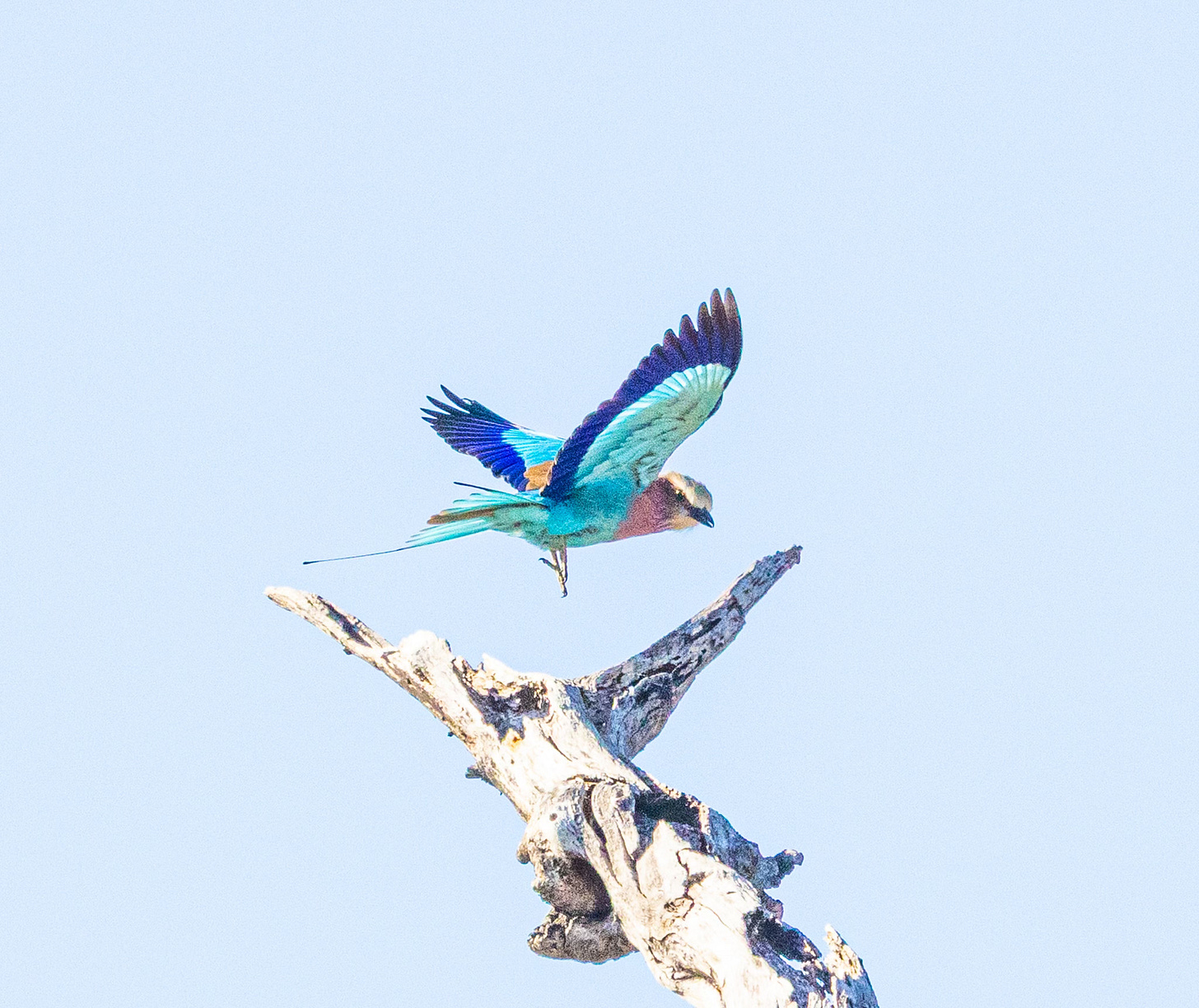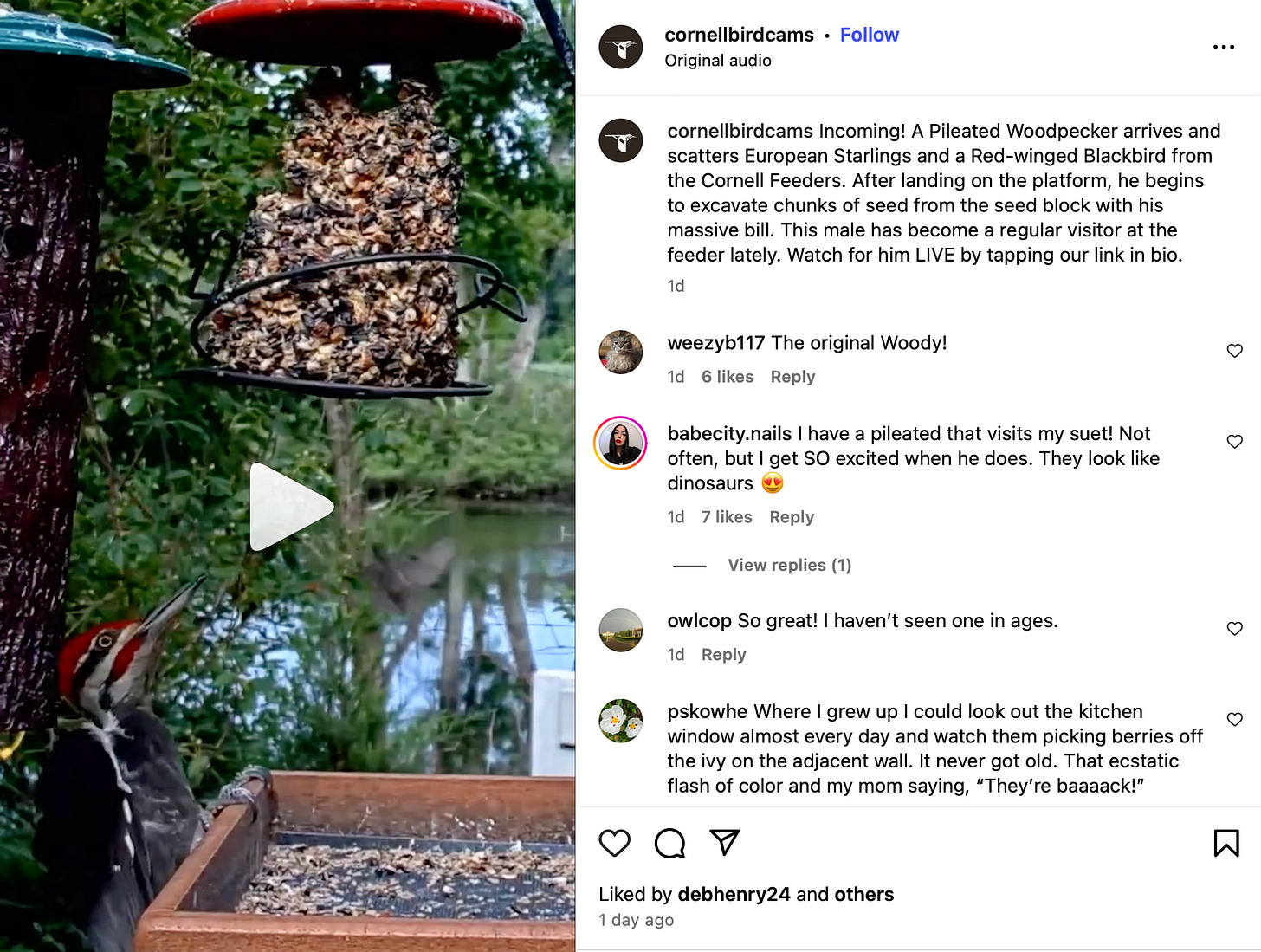1. Let's start with an intriguing essay by an evolutionary biologist on birds and humans - long but worth reading in full: Culture and its transmission from generation to generation is the defining feature of humanity. It is perhaps the best candidate for the thing that separates us from other beasts. Though there are other species that have been shown to hand down accumulated knowledge – including chimps, who show some evidence for cultural transmission of tool-use – no other animal approaches our ability to layer breakthrough upon breakthrough in such a complex way, and certainly no other animal does it with the conscious intent to lift future communities beyond the achievements that came before. That is a human distinction if there ever were one. Why has no other animal evolved this demonstrably useful ability? The philosopher and biologist Peter Godfrey-Smith points to birds as the expected place to find another species treading the same path that we humans have, not least because they already come with several of the important adaptations that made cultural sharing possible for us: complex brains, long lives, strong parental care of offspring in most species, and robust communication. (via AEON)
2. "Swift bricks" and the unusual political spat in the House of Commons: The swift (Apus apus) is an acrobatic aerial bird, a remarkable sprinter and endurance flyer that rarely touches the ground. When these sickle-winged birds do come down – after several years in perpetual flight, even sleeping midair – it is to nest in the eaves of roofs across Europe after spending winters in sub-Saharan Africa, migrating 7,000 miles (11,000km) every year. Three years ago, the writer and bird lover Hannah Bourne-Taylor launched a campaign to oblige every new home to be fitted with a swift brick. When in opposition, the Labour party supported the “swift brick amendment”, first tabled by the Conservative peer Zac Goldsmith, to do this in England. Now in government, Labour is resisting attempts by its own backbench MP Barry Gardiner to insert a swift brick amendment into the controversial planning and infrastructure bill. (via The Guardian)
By Hap Ellis, Little Bee-Eater - Okavango Delta, Botswana.
3. More on the "dawn chorus" study, this time from NPR: Researchers have some new evidence about what makes birds make so much noise early in the morning, and it's not for some of the reasons they previously thought. For decades, a dominant theory about why birds sing at dawn — called the "dawn chorus" — has been that they can be heard farther and more clearly at that time. Sound travels faster in humid air and it's more humid early in the morning. It's less windy, too, which is thought to lessen any distortion of their vocalizations. But scientists from the Cornell Lab of Ornithology's K. Lisa Yang Center for Conservation Bioacoustics and Project Dhvani in India combed through audio recordings of birds in the rainforest. They say they didn't find evidence to back up this "acoustic transmission hypothesis.” (via National Public Radio)
4. When it comes to protecting migrating birds, every effort matters: BirdLife International is proud to stand with partners across South-West Asia in launching a new South-West Asia Illegal Taking of Migratory Birds Intergovernmental Task Force— a critical step toward protecting some of the most iconic, vulnerable, and endangered migratory bird species. Launched during a high-level meeting in Riyadh, Saudi Arabia (20–21 May 2025), the South-West Asia Illegal Taking of Birds Task Force (SWAITBT) was established under the Convention on the Conservation of Migratory Species of Wild Animals (CMS). This new alliance brings together ten countries from across the region—Bahrain, Iran, Iraq, Jordan, Kuwait, Oman, Qatar, Saudi Arabia, United Arab Emirates, and Yemen—united by a shared responsibility to safeguard migratory birds. (via BirdLife)
5. Birds, bats and pest control - a new study highlights their "ecological and economic value": Land use change and the increased agrochemical use associated with agricultural intensification significantly alter farmland biodiversity and associated ecosystem services worldwide. Vineyards as ecologically, culturally, and economically important agroecosystems, are particularly vulnerable, facing numerous pests and diseases, while only a small proportion adopt sustainable management practices. Nevertheless, under suitable conditions, vineyards can support diverse and abundant predator communities capable of delivering effective natural pest control services. Birds and bats, in particular, play a key role by consuming large quantities of insect pests. However, their contribution to biological control—especially in European permanent crops—remains understudied. (via Phys Org)
6. Drones unleashing..."lab-reared" mosquitoes? Yes! Thousands of them - In Hawaii, to save native birds: Colorful songbirds known as honeycreepers were once abundant in Hawaii, filling the air with their chipper songs and vibrant plumage. However, these native creatures are now struggling to survive because of avian malaria, a fatal disease transmitted by invasive mosquitoes. Of the more than 50 species of honeycreepers that once lived throughout the islands, just 17 remain today. Now, scientists have come up with a clever plan to help the birds rebound. They’re using drones to drop thousands of lab-reared, non-biting male mosquitoes engineered to carry a bacteria strain that interferes with reproduction. When these special males mate with wild females, the resulting eggs will not hatch, which should reduce the overall mosquito population and give the birds a much-needed break. The project is spearheaded by “Birds, Not Mosquitoes,” a coalition of state, federal, private and nonprofit organizations working to protect native Hawaiian birds. (via Smithsonian Magazine)
By Hap Ellis, Wattled Crane - Okavango Delta, Botswana.
7. Compared to cats and windows, you don't see nearly as much written on the lethality of power lines -but lethal they can be, particularly for raptors: Millions of birds are killed by power lines each year. Sometimes they collide with the lines when flying and are either electrocuted or fatally injured. Other times they are electrocuted when perching on power poles. Power line collisions are one of the leading causes of injury and death for large birds of prey. In Tasmania, an endangered population of wedge-tailed eagles lost 110 individuals to power lines between 2017 and 2023. New research, the first of its kind in Australia, used GPS tracking data to predict which power lines were most dangerous for these eagles. We hope the findings will help protect birds and other wildlife from overhead wires as electricity networks expand. (via The Conversation)
8. Well, we think we knew this - when it comes storks and baby numbers "correlation does not equal causation": A few weeks ago, Feedback waxed lyrical about how correlation does not equal causation after seeing a study that found a link between events on the sun and births of future Nobel laureates (31 May). This prompted reader Tony Lang to write in with a similar tale. “Many years ago I saw an article with two identically shaped graphs, albeit with selective choices for the vertical axes,” writes Tony. “One was the number of live human births in Germany. The other was the number of storks in Germany during the same period.” (via The New Scientist)
9. It's that time of the year - fireworks and nesting birds: With the Fourth of July only a couple of weeks away, people are starting to think about how they will celebrate. For many, that means with fireworks, but Audubon Florida is reminding people how they can impact birds, especially on beaches during the nesting season. In the summers, when coastal birds are nesting on the beaches, they set up string fences to create a barrier around the colonies. They also create signs to hang up on the beaches with information about the birds and the local and state regulations that protect them. Audrey DeRose-Wilson, Audubon Florida’s bird conservation director, said staff and volunteers monitor the birds at their colonies, especially on holidays like the Fourth of July. “Fireworks are really enjoyable for many of us to look at, but between the bursts of color and the noise, they really wreak havoc on coastal birds, especially this time of year when they’re nesting,” said DeRose-Wilson. (via WMNE)
By Hap Ellis, Lilac-Breasted Roller - Okavango Delta, Botswana.
10. The neighbors must love this: On a hill in San Francisco, known more for its views than its visitors, a quiet crowd has started to gather. Every day, like clockwork, people show up in the same spot — necks craned toward the sky. At first glance, it might look like a celebrity sighting. And in a way, it is. "Around April, I started to see photographers up on the hill here," said neighbor Lee Porter. The newcomers drawing all this attention are a pair of great horned owls and their fluffy, wide-eyed chicks. Liam Murphy, a designer and avid birder, said he didn't expect this much flap over a few feathers. (via CBS News)
11. What it takes (sometimes) to keep airports bird free: Ryan MacKinnon scanned a patch of brush from a truck parked inside the airfield at Whitehorse's Erik Nielsen International Airport. "Is that a bird or a gopher?" MacKinnon asked as he spotted something. "It's probably a gopher.” Observations like these play an important safety role at airports. According to MacKinnon, who's with the territorial government's aviation branch, wildlife are a major factor in aircraft safety at an airport — and birds are a particular concern. That's why the airport has installed new devices to help deter wildlife from entering the airfield: scare cannons. Despite the name, the scare cannons do not fire any projectiles. Instead, they use propane and a battery to ignite a series of three loud booms, every 30 minutes between 9 a.m. and 5 p.m. The goal is to reduce the number of birds on the runways. (via CBC)
12. Fun piece from one of our regional favorites - this time on "Brood XIV 17-year cicadas" emerging on Cape Cod: The much-heralded Brood XIV 17-year cicadas have finally arrived. Have they been serenading you? If you’re in the emergence zone, this is really old news at this point, as they emerged weeks ago and most have probably laid eggs and kicked the bucket at this point. But how does this apparent bonanza affect birds? Do they roll around in them laughing, incredulous at their luck? Do they have more chicks? Do they grow morbidly obese? And is it cicayda or cicahda? Thankfully, I’m here to answer all of what I assume are your burning questions about birds and cicadas. Cicahdas. Whatever. (via Cape and Islands NPR)
13. Five more American Kestrels - fun video of first flights: The American Kestrel nest box in Prairie du Chien, Wisconsin, is officially empty! After an eventful week of wing-flapping, raucous feedings, and sibling disputes, all five female chicks have fledged. A frenzy of fledging activity began on day 30 of the nestling period, when three chicks took their first flights within 90 minutes of each other on the morning of June 13. The final two chicks followed suit on June 14 and 15, wrapping up the excitement. Watch a supercut of all five fledges here! (via All About Birds)
By Hap Ellis, Verreaux's Eagle-Owl - Okavango Delta, Botswana.
14. Rare bird alert - how about this bird in Boulder, CO: With dark glossy wings and a neck like a serpent, a tropical anhinga has made Boulder its new perch. The sleek underwater hunter, often seen in the swamps of Florida or the wetlands of Mexico, was spotted hanging out at a pond near 95th Street in Boulder County on June 2. Since then, the female bird, identified by the light-colored plumage on her neck, has come and gone a few times, but she’s stuck around long enough to cause a stir in the birding world. “I was pretty surprised,” said Scott Taylor, director of the University of Colorado’s Mountain Research Station. “It's just the fourth record of one of these birds in the state of Colorado, so it was pretty exciting to hear about it.” And even better: this is the first “chaseable” anhinga in Colorado history. Others, spotted as far back as 1931, haven’t stuck around long enough to fall into that category. (via CPR)
15. And speaking of rare birds, what is the only gull with a circumpolar distribution throughout the southern hemisphere doing in...Wisconsin?: A kelp gull, typically found in the Southern Hemisphere, has been spotted in Milwaukee, Wisconsin, marking the first recorded sighting of the species in the state. The kelp gull apparently mated with a Herring gull and had a chick. The chick subsequently perished. It is unknown if the kelp gull will remain in Milwaukee, but its presence has drawn birders to the city to view it. Milwaukee is hosting a unique visitor. Or perhaps new resident. In either case it's a Wisconsin first. And it has the birding world buzzing. (via JS Online)
* For those who want to dive into the complexities of gull ID, you need Amar Ayyash's The Gull Guide - North America (Princeton) or Pete Dunne and Kevin Karlson's Gulls Simplified (Princeton) - or both!
16. Finally, and on a humorous note, The New Yorker's Shouts and Murmurs caught our eye this week: You learn the alphabet from an eight-foot-tall yellow anthropomorphic bird that irrevocably imprints on you. Big Bird may as well be your dad. You move on to bigger birds (i.e., dinosaurs) and take an intense interest in pterodactyls. This will become the basis for your atheism. Your mom reads you the story of “The Ugly Duckling.” Your dad reads you the story of “The Ugly Duckling.” Your first-grade teacher reads you—not the entire class, just you—the story of “The Ugly Duckling.” You begin to read between the lines. In college, you watch a documentary about factory farming and become a vegetarian. You stock up on feather accessories. It’s kinda your “thing.” You live in a godforsaken city where a three-hundred-and-fifty-square-foot studio above a bodega teeming with cats costs a million dollars. This enrages you. So, you channel this energy into something that is both creative and calming: you build a birdhouse. Then a bird-duplex. Then a bird-three-story-Victorian with a mansard roof, wraparound porch, crown moldings, and a turret. (via The New Yorker)
Bird Videos of the Week
Video by BBC Earth, “Drone Bird Tricks Meerkats”.
Cornell Live Bird Cam - Fledge Watch 2025.
Cornell Live Bird Cam - Birds Collide!
Go Birding!








